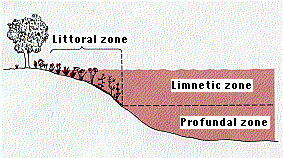Only 3% of the world's water is fresh. And 99% of this is either frozen in glaciers and pack ice or is buried in aquifers. The remainder is found in lakes, ponds, rivers, and streams.
Deep lakes contain three distinct zones, each with its characteristic communities of organisms.
 The zone close to shore. Here light reaches all the way to the bottom. The producers are plants rooted to the bottom and algae attached to the plants and to any other solid substrate.
The consumers include
The zone close to shore. Here light reaches all the way to the bottom. The producers are plants rooted to the bottom and algae attached to the plants and to any other solid substrate.
The consumers include
- tiny crustaceans
- flatworms
- insect larvae
- snails
- frogs, fish, and turtles.
This is the layer of open water where photosynthesis can occur.
As one descends deeper in the limnetic zone, the amount of light decreases until a depth is reached where the rate of photosynthesis becomes equal to the rate of respiration. At this level, net primary production no longer occurs.
The limnetic zone is shallower is turbid water than in clear and is a more prominent feature of lakes than of ponds.
Life in the limnetic zone is dominated by
- floating microorganisms - called plankton
- actively swimming animals - called nekton.
- The producers in this ecosystem are planktonic algae.
- The primary consumers include such animals as microscopic crustaceans and rotifers - the so-called zooplankton.
- The secondary (and higher) consumers are swimming insects and fish. These nekton usually move freely between the littoral and limnetic zones.
Many lakes (but few ponds) are so deep that not enough light reaches here to support net primary productivity. Therefore, this zone depends for its calories on the drifting down of organic matter from the littoral and limnetic zones.
The profundal zone is chiefly inhabited by primary consumers that are either attached to or crawl along the sediments at the bottom of the lake.
Such bottom-dwelling animals are called the benthos.
The sediments underlying the profundal zone also support a large population of bacteria and fungi. The decomposers break down the organic matter reaching them, releasing inorganic nutrients for recycling.
Where there is a pronounced change of seasons, the warming of the surface of the lake in the summer prevents this water from mixing with deeper water. This is because warm water is less dense than cold.
The surface water becomes enriched in oxygen
- some from the air above it
- the rest - because it is in the limnetic zone - from photosynthesis.
But the water in the profundal zone - being removed from both these sources - becomes stagnant.
In the fall, however, as the surface water cools, it becomes denser and sinks to the bottom - carrying oxygen with it.
A similar phenomenon occurs when the ice melts in the spring.
The habitats available in rivers and streams differ in several ways from those in lakes and ponds.
- Because of the current, the water is usually more oxygenated.
- Photosynthesizers play a minor role in the food chains here; a large fraction of the energy available for consumers is brought from the land; e.g., in falling leaves.
Oceans, like lakes, can be described in terms of zones. There are many parallels between the two but unfortunately a separate vocabulary is used for each.
13 December 2001
 The zone close to shore. Here light reaches all the way to the bottom. The producers are plants rooted to the bottom and algae attached to the plants and to any other solid substrate.
The consumers include
The zone close to shore. Here light reaches all the way to the bottom. The producers are plants rooted to the bottom and algae attached to the plants and to any other solid substrate.
The consumers include